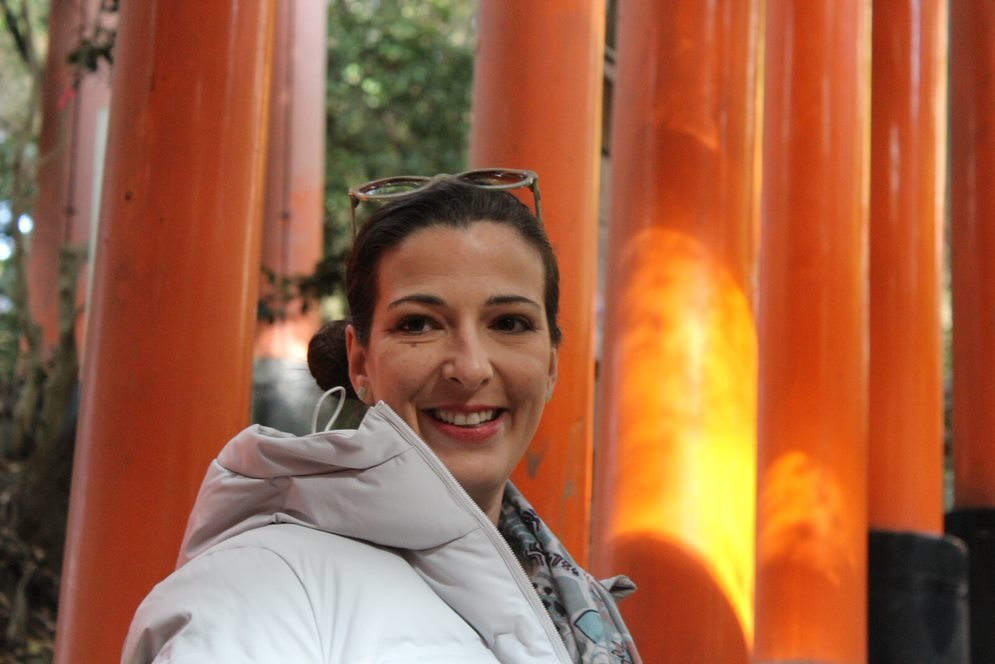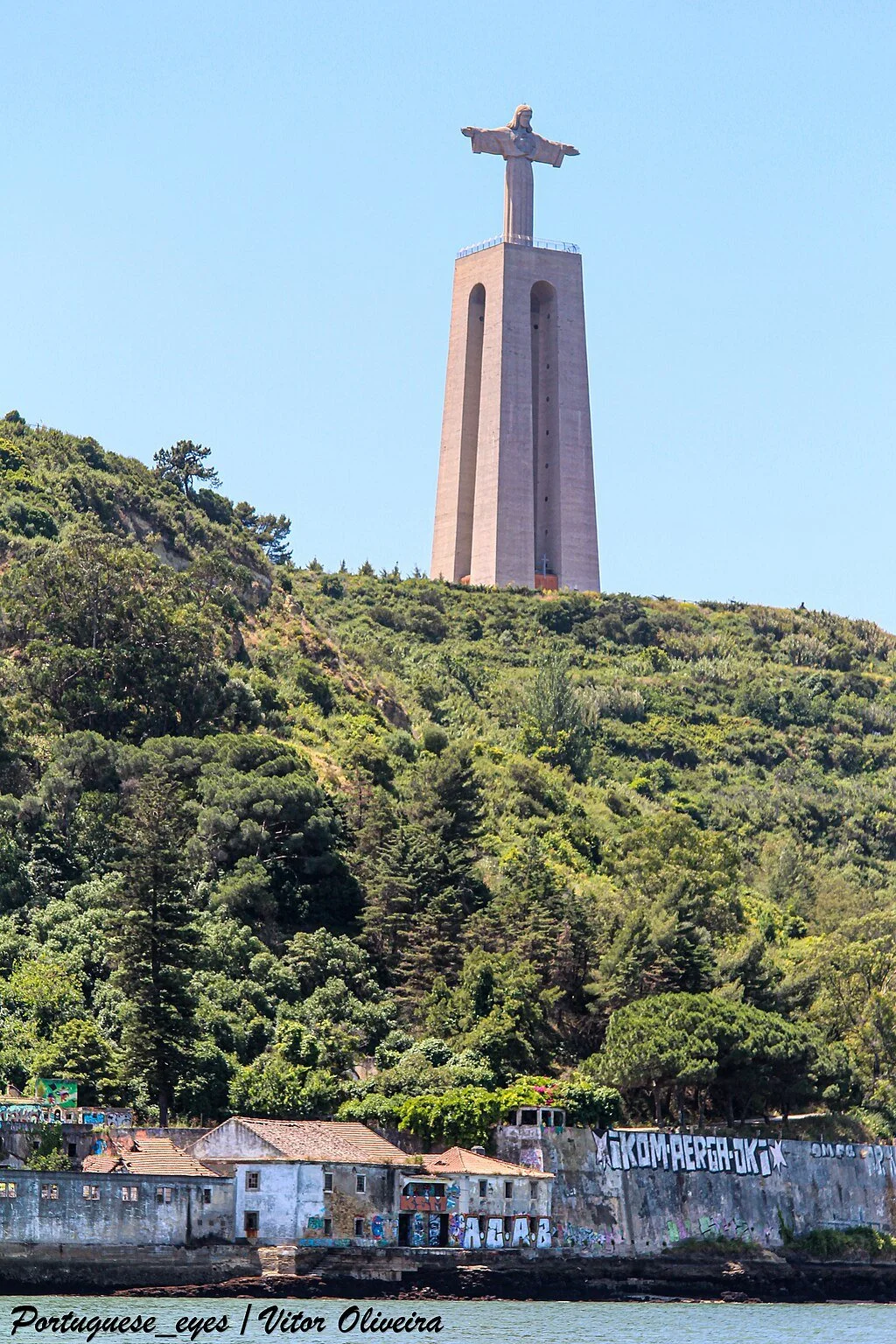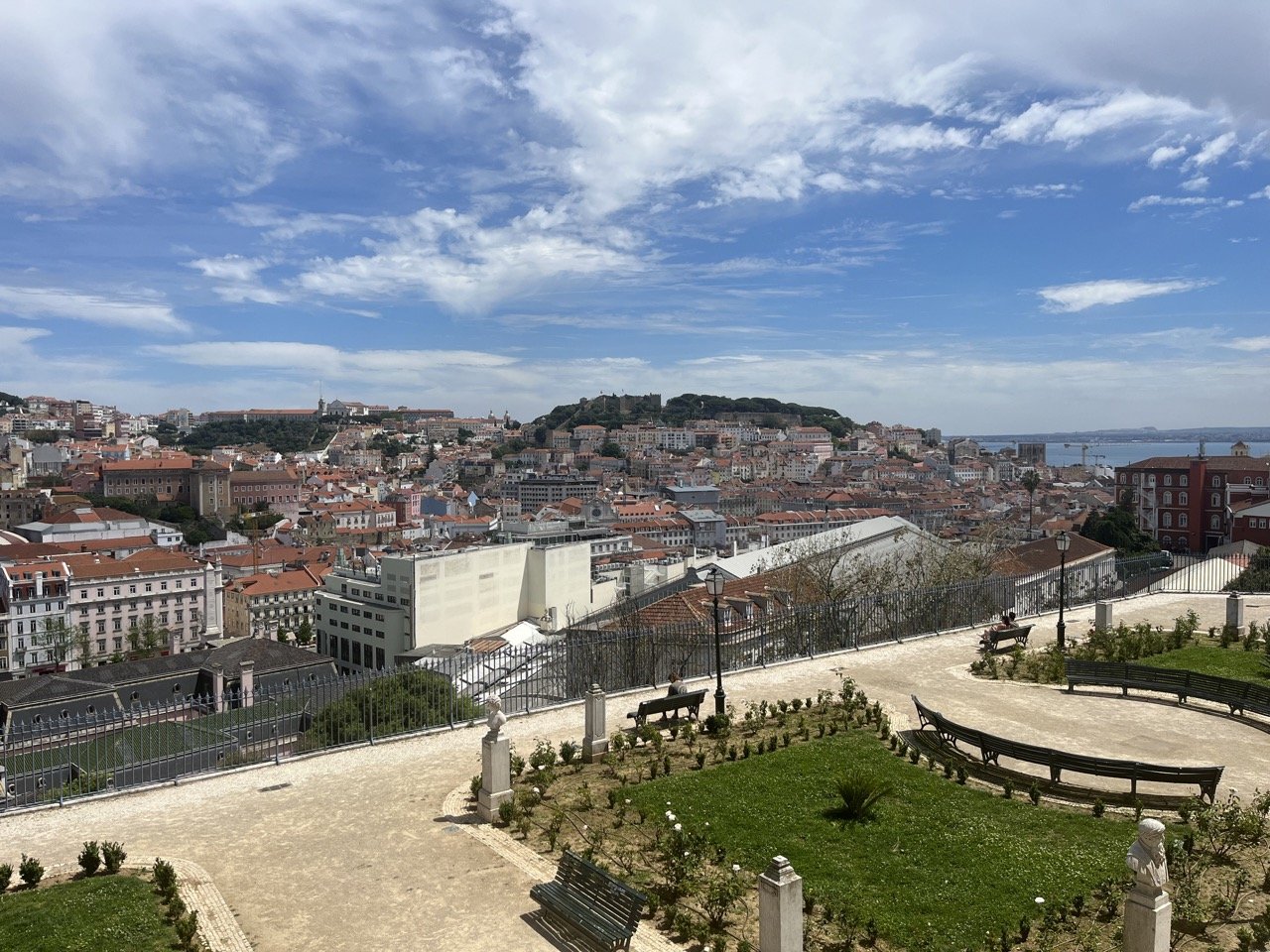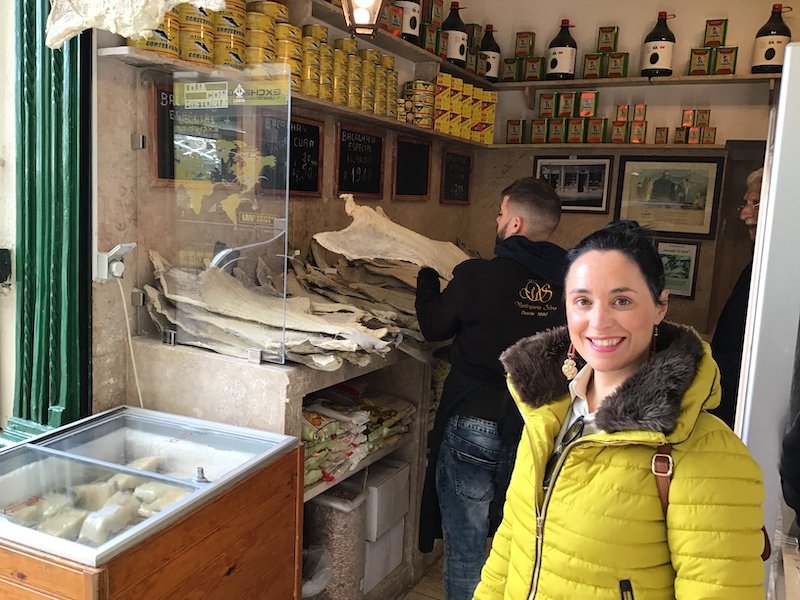A Local’s Guide to Lisbon, Portugal
Please note: some of the links in this article are affiliate links. If you book using one of them, we’ll earn a small commission. All of our info is free to read and free of ads, so we appreciate it!
Whether this is your first visit to Lisbon or your fifth, this city never gets old. Known as the city of seven hills, Lisbon seems to embrace the light like no other place in Europe, and it has long been regarded as one of the best travel destinations on the Old Continent.
Its fame brings tourism all year round, and truth be told, during the busiest times of year there are often more visitors than we locals would like (call us selfish, but sometimes we want our city to ourselves!). But even so, "bonita Lisboa" still retains its soul and its traditions in its neighborhoods, its cafes and restaurants, its imposing monuments, great museums, and gorgeous sunsets from its many viewpoints.
And despite being a global tourism hotspot, Lisbon is in many ways actually still more traditionally Portuguese than Porto, our sister city to the north.
Centuries ago, the ships and explorers that discovered the world did so departing from Lisbon. Things have been flipped around a bit now though, and today, the world is coming here to conquer and discover our city. Times change!
If this is your first visit to the Portuguese capital, you will surely be overwhelmed by all that the city offers. There is a ton to see and do here, so let me start by telling you that you simply will not be able to “do” everything - don’t even try. For that, you'd need to spend weeks here, and even for me, someone born in this city, there's always a new café or trendy restaurant, gallery or museum opening, and a new corner to explore.
To see all of Lisbon would take a lifetime, so don’t worry about checking boxes and doing everything. Instead, focus on just enjoying yourself and taking it all in. A big part of the appeal of Lisbon is that this is city that never stops innovating and rebuilding, so you can always come back again - and the best part is that you’ll have so much more to discover each time you do!
Table of Contents
Lisbon planning cheatsheet
 Plan your itinerary with expert advice
Plan your itinerary with expert advice
- Book a Portugal travel consultation with a local expert
 My favorite hotels in Lisbon
My favorite hotels in Lisbon
- One Palácio da Anunciada - 5-star luxury off Avenida da Liberdade. $350/night
- Palácio das Especiarias - Old World charm & elegance in Chiado. $200/night
- Pousada de Alfama - modern little hotel in the heart of Alfama. $200/night
- Alegria Boutique Hotel - bright and airy rooms in Principe Real. $175/night
- Hotel Lis Baixa - small, but cheerful rooms for a bargain in Baixa. $150/night
- Hotel White Lisboa - excellent value with a pool in Avenidas Novas. $140/night
 Guided tours and activities
Guided tours and activities
- Private guided tours of Lisbon with Inês (my favorite local guide)
- Tastes of Lisbon food tour
- Sintra & Cascais day trip (small group)
- Walking tour of the historic center (3 hours, small group)
- Private half-day Lisbon city tour by Tuk Tuk
 How to get around
How to get around
- Car rentals with DiscoverCars
- Metro and bus/tram routes with MetroLisboa and Carris
- Train tickets from Comboios de Portugal
- Long distance buses at Redes Expressos
- Taxis & rideshares with Uber and Bolt
- Airport transfers from Welcome Pickups


A (very) brief history of Lisbon
Like any European capital, Lisbon is full of history, and that's where you need to start with your visit: because to get to know the city, you must know its past.
Lisbon is one of the oldest cities in Europe and its history dates back to the Phoenicians and, later, to the Romans, who nicknamed it "Olissipo."
Later, in the 8th century, Lisbon was conquered by the Moors and ruled by them for hundreds of years. Owing to this long history of Moorish rule, even today, people from Lisbon are nicknamed "Moors" by those who live in the north of the country, particularly in Porto.
The Christian conquest came in the 12th century, followed by the city's golden era, with the Age of Discoveries (15th and 16th centuries). During this time, Lisbon became a hub for the Portuguese empire and, from its quays, sailed the ships that discovered the sea route to India and other parts of the world.
The Lisbon you see today is very different from what it was then though. The city was devastated by the 1755 great earthquake, which triggered a tsunami and multiple fires, and destroyed huge sections of the city. Marquês do Pombal, the ruler remembered with a giant statue on one of the city's main traffic circles, was responsible for the reconstruction and for transforming Lisbon into a more modern metropolis.
Portugal's capital became the center of everything. It is where the political and financial institutions are located, as well as the headquarters of the leading companies, and where important trade, technology, and industry connections are made with the rest of the world. It also has prestigious universities and research centers.
That's what makes Lisbon unique: the combination of modernity and historical and cultural heritage. New buildings stand alongside old neighborhoods, and restaurants serve modernized gourmet dishes while folks sip traditional aperitifs in longstanding local taverns right next door. And while car horns and the noise of traffic are ubiquitous everywhere nowadays, you’ll still also hear beautiful Fado tunes wafting out onto the streets.
Where is Lisbon and how to get here
Lisbon is located on the west coast of Portugal, on the north bank of the Tejo, Portugal's largest river, which begins in Spain and flows to the sea right next to the city.
Given its importance, Lisbon constitutes a district that includes several outlying towns and villages, such as Cascais, Sintra, or Mafra.
Known for its hills, where traditional neighborhoods such as Alfama, Mouraria, or Graça are located, the city also takes advantage of its proximity to the river and the Atlantic Ocean, with an important riverside and seaside area.
As the country's capital, Lisbon's metropolitan area is quite urbanized and densely populated. It includes industrial zones on the city's outskirts, which can be a nightmare if you're trying to get in and out of the city at rush hour.
How to get here:
Lisbon is home to the main Portuguese international airport, which receives daily direct flights from Europe and the rest of the world (North America included) so you will almost certainly be able to fly straight into Lisbon no matter where you’re coming from.
Also, the vast majority of public transportation connections with other destinations throughout Portugal depart from, arrive to, and cross through Lisbon.
The main train stations are in Santa Apolónia and Parque das Nações, and they have countless daily trains (both high-speed and regional) heading to the north and south of the country. You can also catch the suburban train to Sintra at Rossio station.
Local, medium, and long-distance buses also depart for all over Portugal from the city’s Sete Rios station, (near the Lisbon Zoo), reaching domestic cities and small towns anywhere and everywhere, and even international destinations such as Spain or France.
How long to spend
By now, you have probably realized that to get to know Lisbon by heart, you'd have to spend several weeks here. Of course, you likely don’t have the time to do that, so to get a good idea of the city, I recommend staying here for at least three days.
This will give you enough time to see all the city’s main sights and attractions, explore some more local and off the beaten path areas, and actually enjoy yourself, with time to soak up the city’s atmosphere.
Your first two days should be basically exclusively dedicated to visiting the historic center and checking out the main monuments and landmarks.
Then, on the third day, you have more options: you can get off the beaten path and visit some of the residential neighborhoods that most tourists don’t go to, you can cross over the river and explore Almada, or you can take a day trip to places like Sintra, Cascais & Estorial, Nazare, the Arrabida park, or a host of other historic towns and sites all within an hour or two of Lisbon.
If you want to see exactly how I’d suggest you use your time, check out my 3-day Lisbon itinerary. If you have less time, we also condensed the highlights into this 2-day Lisbon itinerary.
When to visit
For me, the best time to explore Lisbon is between March and May, when the days start to get longer, the temperatures are mild and pleasant, and you’ll have mostly sunny days. And despite the city's reputation for year-round tourism, the crowds are much smaller during this period, and you can easily visit the main attractions without queuing for hours on end.
But let's break it down because there's always plenty to see and do, whatever the season:
Visiting in Fall
Autumn is very similar to spring, with pleasant temperatures ranging from 18º to 25º Celsius and the season's hues taking over the city's main parks and gardens. The visitors brought by summer have already returned home, but this is also the season when Lisboners go back to work and school, introducing increased activity to residential and office areas.
With the onset of the first rains (bring a rain jacket if you’re coming in November), seeing more traffic jams on the roads is no surprise. On the other hand, roasted chestnut sellers appear in the city center and fill the air with an autumnal scent that adds even more charm to the visit.
Visiting in Winter
The rain is more frequent, and the cold is starting to set in. These are the coldest months in the city, with temperatures going as low as 13º Celsius or less, so include some warm clothing in your bag.
If you're looking for a more cultural visit to the city's museums, this is the perfect time to do it. Moreover, the town fills up with Christmas spirit between the end of November and the beginning of January.
From small markets, such as in the Alvalade neighborhood or Rossio Square, to Wonderland Lisboa, which occupies Parque Eduardo VII with an ice rink, a giant Christmas tree, plenty of Santa Claus, and seasonal food and drink.
Visiting in Spring
As I mentioned, Spring is the best time to visit the city. The temperature, around 18º and 23º Celsius, is inviting for late afternoons on a rooftop, and the venues are not yet too crowded. Always bring a jacket with you, as nights are still quite chilly.
It's at the end of this season that Lisbon hosts two major events. The first, the Lisbon Book Fair, fills Parque Eduardo VII with thousands of books from the country's leading publishers. The second is Lisbon’s biggest commemoration.
The Santos Populares celebrate Saint Anthony and flood the streets with festivities, including the Marchas Populares (a colorful parade) on Avenida da Liberdade and the so-called "bailaricos" (dance parties) in the typical neighborhoods, with popular music and the famous grilled sardines. The biggest celebration is June 12 to 13, a night when the city doesn't sleep.
Visiting in Summer
Like any major capital, summer is the busiest season in Lisbon, with tourists everywhere and the hottest weather. With temperatures rising as high as 35º Celsius, fresh clothing, a hat, and plenty of water are must-haves if you’re walking the streets of Lisbon, especially between 11:00 am and 3:00 pm.
This is an excellent time to explore the green spaces and even escape to the beach at Estoril and Cascais or cross the river to go to the beaches of Costa da Caparica. Enjoy sunsets on the beach or by the river, and let the warm evenings win you over as you experience Lisbon's vibrant nightlife, whether in Bairro Alto, at the Pink Street in Cais do Sodré, or in the Santos area.


Where to stay
There are an absolute ton of accommodation options in Lisbon, and new places are constantly popping up all over the city, so you’ll never struggle to find somewhere to stay here. However, prices are rather expensive, especially during popular times of year, and many of the best options book out pretty far in advance, so you do need to plan ahead.
Also, as you might guess, being one of the most popular cities in Europe does have some drawbacks, and of one of them is that Lisbon’s more central neighborhoods suffer from a fair deal of overtourism.
Keeping that in mind, here are the neighborhoods that I think are the best bet for most travelers:
Baixa and Chiado - our central, busy downtown
Comprising Lisbon’s historic “downtown” these two central neighborhoods are ideal for those with limited time and who want to be close to all the main sights and have good public transport connections. They’ve very touristy and quite commercial however, so may not be to everyone’s taste. They are also among the most expensive neighborhoods for hotels in the city.
Alfama and Mouraria - historic and charming, but very touristy
If you’re after historic charm, a medieval vibe, and easy access to the major sites, Alfama and Mouraria are your best bet. Much of Lisbon was destroyed in the earthquake of 1755, meaning that a lot of the city is more modern than most people expect. However, these neighborhoods survived the disaster mostly intact, so they are still lovely historic centers.
They’re also extremely touristy because of that, and you will find far, far more tourists than locals here. Shops and restaurants cater to visitors as well, so just be aware that this is very much a tourism-focused part of the city.
Principe Real - upscale and residential, but less central
A bit removed from the center of the city but not too far away, Principe Real is an affluent part of town very popular with well-off residents. Despite being on the border of Lisbon’s downtown, it’s almost completely residential and offers a very pleasant but distinctly local atmosphere.
It has broad boulevards with lots of nice shops, great restaurants and cafes, and a nice selection of mid to upper-tiered hotels. It’s well connected to the rest of the city by metro, so is convenient for getting around as well.
How to get around the city
Lisbon has an excellent and comprehensive public transportation system, so you can easily and quickly move all about the city without every having to get in a car.
On top of that, the traffic is notoriously terrible within the city, so my recommendation is that you don’t even think about renting a car while here. Public transport and your own two feet (plus maybe a bicycle if you’re up for it), will get you everywhere you need to go without problem.
In addition to the heavy traffic, parking is scarce near the main tourist attractions and in the historic neighborhoods, so even if you had a car, you’d probably have nowhere to park it. So do as I do when exploring this city: put on some good sneakers and get ready to walk. Honestly, this is the only way to really get a feel for the city’s essence anyways.
Transportation options:
The Metro: First up is the metro - with its four lines that criss cross the city and trains that run from 6:30 AM until 1:00 AM, this is likely to be your best bet for getting just about everywhere. Tickets are easy to buy and you can even tap to pay with your (contactless) credit cards at the validation machines now, making it even simpler. Find routes, timetables, and more info on the official website here.
Buses, trams, funiculars, and lifts: For areas that aren’t covered by the metro, or routes that just aren’t convenient for it, there’s also a comprehensive network or buses, trams, funiculars, and “lifts” (really just the famous Santa Julia elevator).
The trams and funiculars are mostly found in the historic center, which is too hilly for metro construction to have been feasible, while buses are basically everywhere. You can find lots more info on the trams (some of which are historic and mostly used for touristic purposes) here.
And in case you’re out late into the evening and need to catch a ride, there is a limited selection of night buses that cover a few routes (there are even more night bus options during the weekend).
Urban train: If you want to get out into Lisbon’s surroundings, visiting nearby points of interest (Cascais, Estoril, Sintra, etc.), you can take the urban train, which departs from Cais do Sodré station.
If you don't want to worry about buying tickets for any of this, you might want to look into the Lisboa Card, which includes free rides on the metro, buses, streetcars, elevators, and CP trains. It also gives access to various museums and monuments.
Hop-on Hop-off Bus: Finally, for a purely touristic (but very convenient) transport option, you can also choose one of Yellow Bus's hop-on, hop-off tours, which will take you around the city by bus, streetcar, or boat.
What to see & do
Now, let's get down to business and find out what you can see and do in this wonderful Portuguese city.
To include everything Lisbon has to offer would require two or three endless articles, so, here are the places and activities that I think are essential for a first visit:
1. Mosteiro dos Jerónimos
A bit outside of the city center in Belém, the Mosteiro dos Jerónimos is one of those monuments that you simply can’t miss; its massive size means that it quite literally stands out and over anything else in the neighborhood.
This magnificent structure, a UNESCO World Heritage Site, is home to the tombs of some of Portugal's most notable personalities, such as the navigator Vasco da Gama, the poet Luís de Camões, and the writer Fernando Pessoa.
The Church is fabulous, of course, but don’t stop there - go inside the monastery as well, which is well worth a visit.
2. Torre de Belém
Another UNESCO World Heritage Site, the Torre de Belém is a 16th-century fortified stone tower located beside the Tejo River and just a 15-minute walk from the Jeronimos monastery. This monument marks the place from which Portuguese navigators set off to discover foreign lands during the Age of Discovery, bringing unbelievable wealth and power to this little country.
When here, you can go inside the tower for a visit, but don’t feel bad if you choose to skip that part - the real allure is just seeing the monument from outside, enjoying its wonderful setting, and considering the lasting impact of that period of Portuguese conquest.
Torre de Belém
3. Castelo de São Jorge
At the top of Lisbon's highest hill, the Castelo de São Jorge looms over the city, a reminder of when it was under Muslim occupation and the first Portuguese king's subsequent seizure of the fortress from the Moors.
So take on the challenge of climbing up the hill, then scale the castle’s walls and enjoy the incredible view over the city's rooftops. Inside the main square of the fortress you’ll also see what few ruins remain of the old Paço Real da Alcáçova.
The view from the castle's walls. Photo: Simon Burchell, CC BY-SA 4.0, via Wikimedia Commons
4. Panteão Nacional
The Panteão Nacional (National Pantheon) is an impressive 17th-century baroque church converted into a mausoleum, serving as a burial place for famous or revered Portuguese. You can see its iconic dome from various viewpoints around the city.
Inside the building you’ll find the tombs of Almeida Garrett, the great promoter of theater in Portugal, the fado singer Amália Rodrigues, the poet Sophia de Mello Breyner Andresen, and, more recently, the soccer player Eusébio, among others. If you visit on a Tuesday or Saturday, be sure to stop by the Feira de Ladra (Lisbon’s flea markert), which takes place in the the nearby Campo de Santa Clara.
Photo: Arne Müseler / www.arne-mueseler.com, CC BY-SA 3.0 DE, via Wikimedia Commons
5. Sé de Lisboa
Built over 800 years ago, this is the city's oldest and most iconic cathedral. The imposing twin stone towers that stand on either side of the entrance make quite a powerful impression, but the interior, with its impressively high vaulted ceiling and magnificent stained glass windows, is even better.
Climb up to the High Choir for a more comprehensive view, and be sure to also check out the excavations in the cloister, which reveal Roman, Visigothic, and mediaeval ruins.
6. Cristo Rei
Just across the Tejo River from Lisbon is its sister city of Almada, which holds one of “Lisbon’s” most iconic sights: the Cristo Rei Sanctuary. Set on a high cliff overlooking the river, this enormous statue of Christ was built in the likeness of the Christ the Redeemer statue in Rio de Janeiro, which you’ve surely seen photos of.
This is an absolutely towering monument - it stands 110 meters tall (including its pedestal), and the image of Chris reaching out toward Lisbon, seemingly embracing the city, is an unforgettable sight. You’ll also enjoy incredible panoramic views over the city, the 25 de Abril Bridge, and the surrounding landscape.
Photo: Vitor Oliveira from Torres Vedras, PORTUGAL, CC BY-SA 2.0, via Wikimedia Commons
7. Centro Cultural de Belém
The Centro Cultural de Belém is one of Portugal’s leading cultural venues, and it’s a massive complex that puts on all sorts of performances and events - from concerts and film screenings to operas, plays, and the ballet. It’s always worth checking their program to see if they have any shows/performances going on during your visit.
The complex also has an exhibition center that includes numerous galleries dedicated to different art forms and styles, including a collection of works by artists like Pablo Picasso, Salvador Dalí, Joan Miró, and Andy Warhol (among many others).
Photo: Vitor Oliveira from Torres Vedras, PORTUGAL, CC BY-SA 2.0, via Wikimedia Commons
8. MAAT
Since we’re already on the subject of art and culture, this is a good place for me to mention the MAAT - Museum of Art, Architecture, and Technology. Also in Belém and housed in an incredible modern structure right beside the river, the building itself is actually the main reason to come here, as it is simply outstanding.
The museum’s exhibits are nice too, but when I visit, it’s just to walk along the river and gawk at the awesome architecture.
The Museum of Art, Architecture, and Technology (MAAT). Photo: Herbert wie, CC BY-SA 4.0, via Wikimedia Commons
9. Museu Nacional de Arte Antiga
I’ve focused on a couple of modern/contemporary art museums above, but don’t worry, if your taste runs more to the classics, the Museu Nacional de Arte Antiga (National Museum of Ancient Art) is sure to provide what you’re looking for.
The museum’s collection includes more than 40,000 items and covers a huge range of art forms: sculpture, metalworking and jewelry, painting, ceramics, textiles, and others. While Portuguese art is one of the museum’s focuses, they also have works from all over the world - Asia, Africa, elsewhere in Europe, and even the Americas.
The “São Vicente Panels” by Nuno Gonçalves and the “Adoração dos Magos” (Adoration of the Magi) by Domingos António de Sequeira are two of the best-known works of Portuguese painting, and my national pride insists that I suggest you be sure to check these works out.
The São Vicente Panels in the Museum. Photo: Nuno Gonçalves , Public domain, via Wikimedia Commons
10. Love museums? Here are a few more…
Museu Nacional dos Coches
As the name implies, this museum is dedicated to the coaches and carriages once used by Portugal's royal families and nobility. The detail, richness, and splendid decoration of these “vehicles” is seriously impressive.
Make sure to take a look at the carriage in which the last King of Portugal was assassinated, where you can see the holes left by the bullets fired in the attack.
Lisbon Story Center
Most of the museums that I’ve mentioned so far are national or even global, so this one represents a change of pace - it’s fully dedicated to sharing and documenting the history of your host city - Lisbon!
Through interactive multimedia exhibits, and with an excellent audioguide, the museum will take you through the city’s entire history, from Phoenician times through to the modern day. You can usually visit pretty quickly (around an hour), and you’ll leave with a much better understanding of the city you’re visiting.
Oceanário de Lisboa
For anyone who loves aquariums, or is perhaps traveling with kids who do, this is a great spot to visit. One of the largest aquariums in the world, there’s a vast array of different marine life to be seen, especially the gigantic main tank that has no shortage of sharks!
It’s located well outside of the center in modern Parque das Nações, so you’ll have to catch the subway to get out here. A trip here is also a good excuse to have a look around the neighborhood, which is quite different from the other areas you’ll have likely visited during your trip.
Centro de Ciência Viva
Another great choice if you’re visiting Lisbon with kids in tow, the Science Center is a wonderfully interactive and informative museum that will surely entertain your little ones (and probably you too).
Centro Interpretativo da História do Bacalhau (the codfish museum)
During your visit to Portugal, whether you like it or not, cod will simply be a part of your life. After all, the Portuguese have a thousand and one ways of cooking this fish, and it will be on the menu at almost every restaurant.
Well, if you want to better understand our close relationship with this fish and its significance to the Portuguese country and people, this the place to go. Located in the East Tower in Praça do Comércio, this is a fun and interactive museum that will tell you everything you need to know about our history with this beloved fish and the broader Portuguese relationship with the sea.
Carriages in the National Coach Museum. Photo: Geerd-Olaf Freyer from Aachen, Deutschland, CC BY-SA 2.0, via Wikimedia Commons
11. Teatro Nacional D. Maria II
Located in Rossio Square, one of the most emblematic places in downtown Lisbon, the Teatro Nacional D. Maria II is itself an iconic venue. Our national theater, it’s the most prestigious hall in the country, and they put on supremely high-quality productions.
Even if you don’t make it to a performance, you should still admire the building, with its glorious, Neoclassic and columned facade. As a rather dark little aside, you might be interested to know that the theater stands on the grounds of a former palace, from where the Portuguese Inquisition took place. As you could probably guess, the history of that palace was rather gruesome.
Rossio Square, with the Theater in the back (with the columns)
12. Praça do Comércio
Praça do Comércio, also known as Terreiro do Paço, is a grand public square on the river's edge in downtown Lisbon. This wide, open-air space is framed by classical 18th-century Pombaline buildings, with the imposing statue of King José I at its center.
Destroyed in the 1755 earthquake, the square was one of the centerpieces of the city’s reconstruction and is today a vibrant place, hosting major events like our New Year's Eve celebration.
Many people refer to the square as the city's "living room" because we all like to go there for a little break at one time or another, even if only to quickl take in the breathtaking view of the river.
Photo: Ajay Suresh from New York, NY, USA, CC BY 2.0, via Wikimedia Commons
13. Parque Eduardo VII
This is one of my favorite green spots in the city center. In addition to having large lawns, this is where you access the Estufa Fria de Lisboa, a garden within a garden. In this iconic greenhouse, you can follow paths that take you through lush vegetation and hundreds of plant species from all over the world.
Parque Eduardo VII
14. Parque Florestal de Monsanto
They call it the "lung of Lisbon," as it is the largest forested area in the city. Located on Lisbon’s western edge, the park extends over 900 hectares (it's one of the largest city parks in the world) and is full of trails and cycling paths, as well as several viewpoints, picnic areas, and children's playgrounds.
If you love keeping fit while traveling, this is the ideal place to exercise, with several fitness circuits. Although Monsanto Park has improved in recent years, I advise you to use it during the day, as it's a rather isolated place to go at night.
15. Jardim da Estrela
The Jardim Guerra Junqueiro, better known as Jardim da Estrela, is located right in front of the beautiful Basílica de Estrela and is a delightful natural place to escape the hustle and bustle of the city.
In this romantic 4-hectare garden, you'll find a lake with ducks and koi fishes and an incredible iron bandstand built in 1884. It's the perfect place to unwind at the end of the day.
Photo: Vitor Oliveira from Torres Vedras, PORTUGAL, CC BY-SA 2.0, via Wikimedia Commons
16. Stroll along iconic Rua Augusta
This is the shopping street par excellence of downtown Lisbon. Stretching between the arch of Praça do Comércio and Praça do Rossio, this pedestrian street is lined with several well-known brand stores, restaurants and cafés. It is also frequented by street artists and street vendors.
The terraces in the center of the street can also be appealing, but the price and quality of the products served sometimes fall a little short.
As one of Lisbon's most famous streets, you may be approached by people selling illicit substances, so just firmly say “no thanks” and move on.
Photo: paul Barker Hemings from seregno, 85, CC BY-SA 2.0, via Wikimedia Commons
17. Shop (and eat) with the locals in Campo de Ourique
The Rua (street) Coelho da Rocha takes you right through one of the city's most beloved neighborhoods: Campo de Ourique. This area, apart from being the place where the writer Fernando Pessoa chose to live in the 1920s, is where you’ll find the beloved Campo de Ourique Market (a market and food hall that is much more authentic and local than the Time Out Market), along with lots of grocery stores, traditional cafés, local restaurants, and so-called "neighborhood stores."
If you want a taste of real Lisbon life, this is the perfect place to go for a wander.
The food hall in Campo de Ourique Market. Photo: Mercado de Campo de Ourique, CC BY-SA 4.0, via Wikimedia Commons
18. Take a sunset cruise on the Tejo River
Being on the banks of the Tejo and not enjoying the river is unthinkable. In addition to having a drink on one of the riverside terraces, go further and embark on a small cruise to watch the sunset.
Several companies take you from the River Station, past Terreiro do Paço and the 25 de Abril Bridge, to the Torre de Belém. Let yourself fall in love with the warm end-of-day colors as they set over the city.
19. Stay up way too late partying in Cais Sodré
You can also take the city's pulse at night with plenty of bars and clubs where you can have a drink and a good time. In Cais Sodré, Pink Street is one of the most popular spots, so expect a lot of activity here. In addition to the various bars, go early to guarantee entry to Pensão Amor.
This burlesque house puts on multiple shows, concerts, and DJ acts. Also nearby is Musicbox, known for its concerts and clubbing sessions.
If you want to dance the night away, here are two of my favorite places: Incógnito, one of the city's first alternative venues, and Lux Frágil, one of Lisbon's biggest nightclubs.
Pink Street. Photo: Benjamín Mejías Valencia from Santiago, Chile, CC BY 2.0, via Wikimedia Commons
20. Catch a Fado show
Going to Lisbon and not seeing a Fado show is like going to Rome and not visiting the Vatican. You can watch fado shows in many places, such as Mesa de Frades in Alfama, and Adega Machado or Faia in Bairro Alto.
To better understand the history of this unique Portuguese musical genre, stop by the Fado Museum.
Fado musicians. Photo: Pacopac, CC BY-SA 4.0, via Wikimedia Commons
21. Climb up the 25 de Abril bridge
Unlike other bridges worldwide, the 25 de Abril Bridge is closed to people on foot, but since 2017, it has been possible to climb up one of its pillars. It's called the Pilar 7 Experience, and you can take the elevator next to the bridge pillar on Avenida da Índia and then climb up to the deck to enjoy the view.
The 25 de Abril Bridge. Photo: Unianayet, CC BY-SA 4.0, via Wikimedia Commons
22. Check out the very cool Lx Factory
In Alcântara (a somewhat out of the way but up-and-coming neighborhood), the LX Factory occupies a series of formerly abandoned warehouses which have now been repurposed to house trendy stores, restaurants, art galleries, and even tattoo parlors. They also have sort of pop-up markets periodically, so check their website if you want to see if there’s anything planned for or going on short-term during your visit.
And don't leave without browsing the books in the incredible Ler Devagar bookshop, located in an old printing plant. It’s an awesome space.
A street in the LX Factory complex. Photo: Pacopac, CC BY-SA 4.0, via Wikimedia Commons
23. Shop and eat in some of the (many) markets
Lisbon is a city of markets, even more so since the old fruit, fish, and vegetable markets have given way to trendy places where you can have a meal or a drink. There’s the Time Out Market in the old Mercado da Ribeira, the Arroios Market, and the Campo de Ourique Market.
At the organic farmers' market held every Saturday in Principe Real, you'll find fruit, vegetables, and even sweets from local producers. If you're passionate about antiques and collectibles, don't miss the classic Feira da Ladra, dating back to the 13th century, in Campo de Santa Clara (Tuesdays and Saturdays).
Vendors’ booths in the Feira da Ladra. Photo: Shadowgate from Novara, ITALY, CC BY 2.0, via Wikimedia Commons
24. Hunt down as many of the city’s great “Miradouros” (viewpoints) as you can
The advantage of visiting a city built across hills is that you have lots of opportunities to see it from different angles. And Lisbon offers this up in spades, with more viewpoints than you could possibly make it to in a single visit.
My favorites are the Miradouro das Portas do Sol and the Miradouro de Santa Luzia. They both offer a beautiful view of Alfama and the river.
Another great spot is the Miradouro de Nossa Senhora do Monte, the highest in the city. You can also enjoy stunning views from Castelo de São Jorge and Miradouro Sophia de Mello Breyner Andresen, which every local knows as the Miradouro da Graça.
As if that weren't already enough, other viewpoints have emerged over the years, such as the one at Pilar 7 Experience or the top of Tower 1 in the Amoreiras Shopping Center, which offers a 360º view.
The view from the Miradouro de Santa Luzia. Photo: Juan Antonio F. Segal from Madrid, Spain, CC BY 2.0, via Wikimedia Commons
25. Be on the lookout for street art
Wandering around Lisbon you'll see real works of art in the form of street murals all over the city, but the best places to spot them are Graça, Santa Apolónia, São Bento, Olaias, or Marvila.
The latter (Marvila) is also where you’ll find the Underdogs Gallery, a project led by Alexandre Farto, also known as Vhils, and home to several other works by local artists.
Photo: Maria Eklind, CC BY-SA 2.0, via Wikimedia Commons. Cropped from original
26. Walk out atop the Aqueduto das Águas Livres
You would think that climbing the great aqueduct you see from the air when landing in Lisbon would be part of every tourist itinerary, but this monument often goes unnoticed. Built in the 18th century, the Aqueduto das Águas Livres is an impressive stone structure designed to bring water to the capital's fountains.
The aqueduct stretches over 18 km and features 109 stone arches, with the tallest going as high as 65 meters (213 feet). Today, you can visit it on a route that takes you from Campolide to Parque de Monsanto, walking along the top and enjoying the views of Lisbon.
The views from the Aqueduto das Águas Livres
More Portugal travel info
For more advice on planning your trip, check out some of our other guides and itineraries!



Connect with a Portugal expert











































